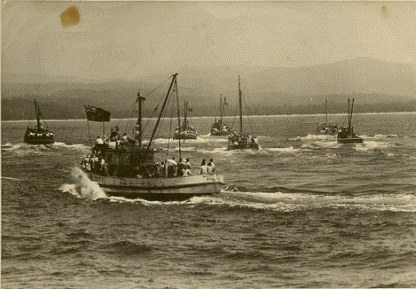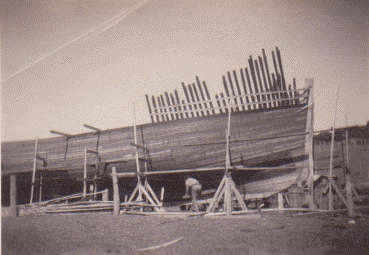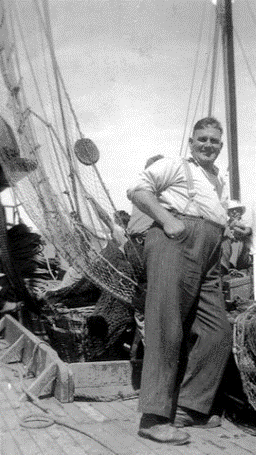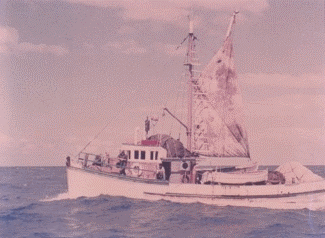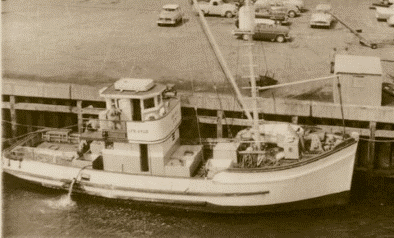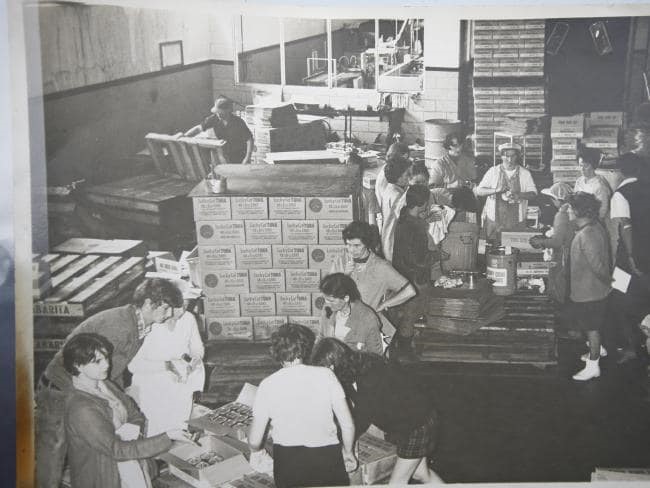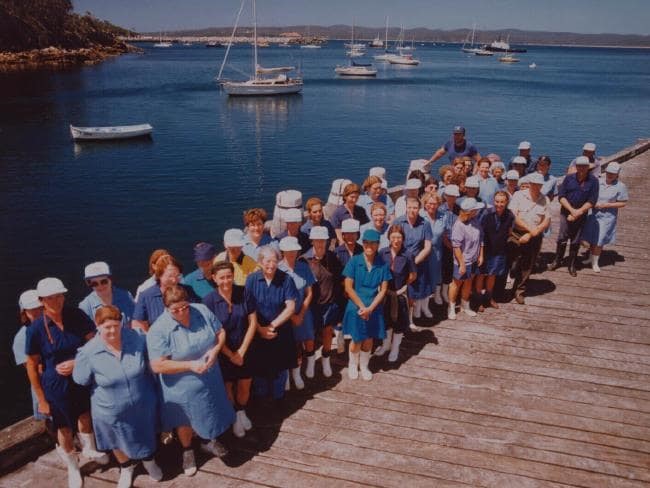Commercial Fishing
Fishing in Eden - Memories of Geoff Collett
Most of my early days were spent at Wonboyn. I left there Dec 1945, went to Eden until 1947, then to Bermagui to 1948 and in January 1949 moved to Tasmania for 15 years. I came back to Eden in 1965. The photos in Eden Remembers bring back many memories.
My father came to Eden/Kiah 1908, worked for Dan Kelly for 6 months and then for Will Whalan, and bought Wonboyn property 1910. He passed on many memories and stories of happenings in the district.
Evidence of early Aboriginal fishing was to be seen in a cave at Greenslade (Greenslade is the original name, Greenglade is an Ivor Thomas Jones invention) There was a deep bed of ashes thoroughly impregnated with fish bones and scales. Many a good meal of, in season, grilled mullet. This was before European settlement. At the foot of the hills midway along Roxby, now known as North Wonboyn Beach, there is an overhanging cliff and Aboriginal midden, many shells and some fish bones. About 8 feet up there is an excellent white drawing of a Lyrebird. I last saw this in 1944.
I understand Captain Skelton, who had a house and 80 acres of land there, named Roxby. My father bought it and moved the house to his property at Wonboyn by horse and cart and boat up river. The Good Old Days were not bothered by bureaucracy. My own Aboriginal descent friends and acquaintances include members of the Holmes, Brierley, Squires, Cruse, Butler and Nye families.
Ocean haul, abalone were fished, I supplied the boat and compressors, (past my free diving days and not changing) and tuna I poled with or alongside most of them. I recall helping with a census paper for Cissie Holmes, daughter of Walter Brierley, mother of Jim, Peter and William (Goo) Holmes and others, where she quoted her ethnicity as “Quadroon”.
The NSW Government around 1914 I think, in the hope of establishing a trawl fishery, purchased second-hand steam trawlers in Britain. A government research vessel “something Endeavour” which was later lost without trace did initial research.
The successful steam trawlers were later sold to private entities – Red Funnel, Cam and Murrel to name just three. Their fishing was based in Sydney and extended into Bass Strait or the Paddock as it was known to within a few miles of the Flounder oil platform position.
Their visits to Eden were for shelter, stores, doctors, pubs etc. Not essentially in that order. A couple were wrecked. The vessel ‘Gunnedah’ lost on Cape Howe right on the Victorian / NSW border. The vessel ‘Olive Cam’ lost between Haycock and Saltwater Creeks. Another, I forget the name, was disabled by Japanese sub gunfire and drifted ashore between Batemans Bay and Durras. The story goes that the sub surfaced alongside and demanded oil and fish. Some brave or foolish idiot on the trawler fired a rifle at the sub. The rest is history. These vessels were requisitioned for mine sweeping during WW2 and in the end age and operating costs; coal fired etc. saw an end to them.
Danish seining started around mid-1930s. I don’t know much detail. Bill Warn had told me he had ‘Marlin Star’. Must have been for 3 years before, in 1942, all but one were confiscated by the R.A.N. or American Small Ship Division. As he once said, having long lined for snapper for 18 years, he thought he knew all the reefs but in three years Danish seining he found ten times as many. The story of Australians on American Small Ships is told in the book The Forgotten Fleet by Bill Lunney. Not to be confused with another of the same name by another author and another fleet, the R.N. ships in Pacific operations in WW2.
One Danish seiner was ‘Alathea’, 36 ft. and 18 HP owned by Harry Rose, had the whole coast to himself for a couple of years until the Japanese were removed from New Guinea and nearby islands, when a few more boats became available for conversion and the demand for fish became urgent. The Halvorsen brothers built 3, ‘Tern’, ‘Gull’ and ‘Snipe’. Very deep shaped vessels powered by second hand Gardener bus engines and modified bus gearboxes, not suitable for army support up shallow rivers and coral reefs. They were diagonal planked with a bilge chine. Probably from offcuts from the MLs they were building for the navy. Scrounge what you could get those days. Danish seining continued until slowly replaced when board trawling proved successful and more versatile from late 1960s.
Couta fishing started around 1944 with an influx of 21 ft. boats from Queenscliff, Lorne and San Remo in Victoria. They had been fishing in those places for many years supplying Melbourne fish market. They were not at first saleable in NSW but military needs changed that. Some of the local boats got in on the act; my father and I included. Buyers who had their contracts with military and other outlets purchased the couta on the wharf at a set price. At one time, I think in late 1945 I counted 48 Danish seiners and 64 Couta boats.
There were attempts to start a cannery at Quarantine and near Lake Curalo, near the existing sawmill and at Narooma. Narooma was originally based on the salmon that was known to frequent the waters of Wagonga Inlet but later wherever salmon could be found. Only Narooma succeeded.
Circa 1936 a fishing crew from Mallacoota, Les and Frank Greer, Owen Allen and Hughey Brady, netted and penned twenty two thousand boxes of salmon in Wonboyn Lake. It took around 6 months to ship them out, a truckload a day to Narooma Cannery, two shillings and six pence (25c) a box at the boat; Sounds paltry now, but a small fortune then. Good wages.at the time of $8.00 per week.
The next canning venture was by Reg Adams and Doug Clayton. Australian Fishing Industries (AFI) at Cattle Bay in 1947 Narooma Cannery was bought and later absorbed by Cattle Bay.
Adams and Clayton started at Cattle Bay building small ships for the military, 66 Ft M.F.V.s and 45 Ft tugs. Later seine trawlers Pisces and Aquarius. They also built the first slipway (wharf) and boat repair workshop around that time, 1947. They also had an earlier shipyard at Berry’s Bay, Sydney, later became Stannards.
Marauder at Cattle Bay with Cannery in background
Probably the earliest net fishing method: Market fish such as mullet, bream, blackfish, garfish, trevally and tailor if they could not be avoided as tailor are known as net eaters.
Lakes Entrance Salmon Co Operative representatives visited Wonboyn in 1920s during winter, to market salmon in Melbourne. Otherwise salmon were unsaleable until canning became available.
Boat based beach seining was mainly and still is confined to Bermagui and Eden. Further north it is confined to 4 WD and boat trailer. Not sure what in past. Probably from nearby sheltered water and or four legged horsepower and manpower.
My first introduction into purse seine fishing was with Bill Warn on ‘Eden Star’.’ Eden Star’ was built with purse seining in mind. It was launched on August 3, 1946. I was confused at first by the Doyle family saying it was August 6, until I realized that when I was at the Aug 3 launching the cradle jammed on some slipway ballast and floating did not take place until three days later.
Building the ‘Eden Star’
A 200 by 23-fathom American rig purse seine was obtained on loan from CSIRO Fisheries Division Cronulla. They had the net but no boat or experienced fishing crew to do their research on fishing for mackerel That part was seconded to Bill Warn and crew. CSIRO Fisheries Division, Hobart, made a documentary film on it in 1949. That is where I got an introduction to fisheries research and fairly close contact with those involved, which lasted for the next ten years or so.
‘Eden Star’ circa 1947
Bill took the gear to Tasmania in 1947 but found the 200-fathom net was too short to surround the mackerel schools on 9 out of 10 attempts. They found enough net for a 40-fathom extension but as it was 2 ½ inch mesh. On the first shot, only the ropes of that section came back. This is known in the industry as a Christmas Tree. I joined the crew in August 1948 when they were building a 50-fathom extension from 2¼ inch mesh. Took it to Tasmania during February 1949 and fished successfully with it. The problem then was to get the canneries to handle enough quantity to make the venture viable. Negotiations took place with them and they said “we will take all you can catch”.
Catch 50 tons and receive a telegram, “send no more fish until further notice.” By the time further notice arrived the fish had moved on. Fish are like that. Not like harvesting sand from a sandpit. Warns then also had an ex disposal sale US army 66-foot tug which had been provided with a 100 by 10-fathom pilchard net.
August 1949 – We returned to Eden and tried for mackerel there but sea conditions were not favorable. Power blocks and triplex net winches had not been invented and ‘Eden Star’s purse winch was one designed for Danish seine by Adams and Clayton. On a shot near Montague Island, while pursing the net in a moderate sea swell, we stripped thirteen teeth off the cast iron main winch gear. We then managed to transfer all the net gear to the converted tug that was standing by. No fish, but got all the gear back. There was a new winch with steel gears on order and when fitted there were no more problems there.
Bill Warn
Len Green of Greenfeast Vegetable Canners then owned the Eden Cannery, hence the name Greenseas. Len was keen to get jack mackerel canning a success. Unfortunately, he died around that time and the family was not interested in canning. I was mainly in Tasmania for 15 years after that apart from a couple of brief stints.
I understand the cannery went through a few stages of ownership and management until taken over by Kraft Foods and later by HJ Heinz. The Heinz crew say they tried canning jack mackerel but could not eliminate a bitter taste.
The Michelson brothers, Kevin and Frank, were keen on purse seining anchovy and pilchard at Lakes Entrance from their boat ‘Anchovette’. They eventually convinced Pecks to invest in a fishmeal plant and built ‘Maasbanker’ and ‘Daggerard’ to supply it. Early on they had a problem with the conventional purse seine rig with 4 leads in every norsal. The net fished the bottom in the relatively shallow water, picked up a ton or two of the shell, and took 2 or 3 days to get back.
Being smart and inventive lads, they removed the lead from the net and replaced the weight in the purse ring bridles and purse wire. No more problems. The next purse seine venture was when Safcol purchased the 700 ton ‘Espirito Santo’ from USA and attempted to purse seine tuna. The main problem was they did not import an experienced crew and skipper to train the Australians and neglected to contact any Australians with purse seine experience. Tuna catch I believe was nil. Vessel last heard of being sold overseas. Asia I think. The time must have been very late 1965 or early 1966 as I clearly remember they had lost the propeller nut off their power skiff. Twofold Bay Marine Services (TBMS) machine shop was otherwise busy at the time so John Helmore sent me out to the ship, which had an excellent lathe and material store. I proceeded to make a new propeller nut there. I left TBMS early Feb. ‘66 to fish the Canberra on which I owed payment instalments.
The ‘Maria Luisa’ arrived with a Norwegian skipper and mainly South African crew. Norwegian rig consists of low placed triplex net hauler, bow and stern side thrusters and Controllable pitch (reversible) propeller. No one leaves the deck of the purse seiner. They were immediately successful. Bluefin tuna, with the aid of a chum boat, and striped tuna caught freely. Shortly after that two purse seiners, ‘Janet D’ and ‘Irene M’, built in Korea and skippered by Norwegians, that had been fishing jack mackerel in Tasmania, arrived in Eden and tried for tuna. They were successful except when nets burst and killed the fish for no return. Mackerel nets were not up to the strength and weight of tuna.
Then came ‘Boston Bay’, a purpose built vessel based on the American style purse seiner. American rig (Boston Bay) has a highly placed power block and a power skiff to keep the purse seiner out of the net. The power skiff is also used to hold the net open while brailing. A more risky exercise in Australian and North Atlantic sea conditions.
The previous three were of Norwegian rig low triplex net hauler rather than the high power block and side thrusters and V.P propeller and instead of the power skiff. This was more suitable for rougher sea conditions. ‘Boston Bay’ fished successfully although with an occasional burst net which resulted in the total loss of a whole school of tuna with no return plus a net to repair.
They were not the only ones to have that problem. As far as I know ‘Boston Bay’ and ‘Maria Louisa’ are still fishing in SA. At the end of 1979 a large and fairly new American tuna purse seiner, ‘Frontier’, arrived in Eden, I think courtesy of Heinz.
It did not stay long. I think it failed to get Australian fishing permit and was last seen heading for NZ. Later on another, much older American built tuna seiner, ‘Eastern Pacific’, arrived on the scene, courtesy of Heinz again. It was anchored in Twofold Bay for a few years. Not sure where it went think fisheries management authorities were at last realizing that Bluefin tuna were being over fished. Pat Warren had been telling them that for years.
Meanwhile Kevin Warren and family had converted the ‘Dell R’ to purse seining, having purchased the equipment from Michelson’s of Lakes Entrance. Their fish meal venture had terminated owing to the anchovy schools moving out of range. I do not believe they had been over fished, just moved, fish does that. A few years later I travelled over 50 nautical miles with an almost unbroken dense sounding of bait fish, most likely anchovy, between Babel Island and the oil rig area.
‘Dell R’ fished mainly mackerel for Heinz pet food. Later, they found salmon could also be caught that way. They later fitted out the ‘Moriah’ with the intention of fishing striped tuna. Unfortunately, on the second shot the purse wire fouled the propeller while shooting and tore the stern post out, luckily without any serious injury to crew. The position given to me by David Broder, who was one of the first on the scene with radar and compass, was 6 nautical miles true east from Green Cape. Boat and net are still there.
Warrens then purchased ‘Janet 1’ and converted to purse seine. Another to arrive on the Eden scene was ‘Delamere’ fishing for mackerel and pilchard for tuna fattening pens at Port Lincoln. Since the loss by fire of the fish packing and freezing facility,’ Delamere’ has returned to new owners, Sam Sarin’s outfit at Port Lincoln.
‘Eden Star’ from Tasmania to Eden 1952
‘Eden Star’ at Port Lincoln 1961
I had also been involved in purse seine fishing in a smaller way. A 75-fathom bait net for my tuna live bait and pole fishing with ‘Eden Star’ and ‘Canberra’ and for occasional market fish. Then 1979 onward, until NSW fisheries banned rings on a hauling net, I used a 240-fathom net with a pursed bunt for taking salmon too far offshore to reach with regular beach net. I later added a 150-fathom purse seine I used for mackerel and the occasional salmon for the Melbourne market. This continued when viable until I sold my fishing business in 2006.
An offshoot from tuna fishing occurred when the Michelson brothers tried gill netting for striped tuna. A fishing method developed in Japan with the invention of oval shape monofilament twine that is almost invisible in the water. The nets occasionally fished the bottom in the shallower Bass Strait water, resulting in some school and gummy shark being caught. Striped tuna proved elusive and economically unviable. The nets were then stripped down and converted to 6 ft. deep bottom-fishing gill nets. This commenced the shark gillnet fishery.
To the best of my knowledge, the bottom dropline fishery for Blue Eye trevally was pioneered by Roy Downey on his own initiative when he was master of ‘FRV Liaweenee’ on charter from Tasmania Fisheries Department. Charterers were CSIRO Marine Division, Hobart Tasmania.
I did a couple of months with ‘Canberra’ early 1966, along with Tony Miles ‘Petoni’ and Dingy Bell ‘Nelly Ruth’. Modified shark longline, cray pot or trap floats and 4-fathom droppers, and wire traces. Very rough gear by today’s standards but it worked then and not more than an hour from home. Pat and Barry Warren had done it a few years before.
A small amount in 1940s, hand hauled gear. On at least one occasion I heard first hand of the line having to be cut owing to weight of shark. A little on bottom gill netting for shark and other fish, Jumbo Miller tried it with some success. Also Mick Fourter. The rot set in with that fishery when Mick Dillon came from Victoria. As I hear it he had a Fisheries officer on board observing, Tony Mundy by name. Some brown grouper came up in the net and Dillon, instead of releasing them unharmed, put a knife into them before discarding them. The short story is State fisheries banned monofilament net in total and all gillnetting in ocean waters. No half measures with NSW Fisheries. Not long after that, Dillon came to an end in a wreck on the west coast of King Island.
As for NSW Fisheries, it has often been truthfully said that industry prospers not because of government but in spite of it. Ralph and John Andrews tried netting in Twofold Bay for the larger sharks. Mainly for livers which were a source of vitamin A, pre synthetic vitamin A. I did a month with John while Ralph went with Hughey Ward trying to gill net Striped Tuna. There was one positive outcome of the shark netting. Beach haulers were not bothered with sharks ripping the nets and bags of fish in Twofold Bay for about 40 years.
Prior to that a second net often had to be used and a shark lance carried and used. Question (1) Did we catch all the sharks that frequented Twofold Bay? I personally do not think so. (2) Did the sharks learn that Twofold Bay was a dangerous place for them? Quite likely, Fish are not stupid. Example, I once read an article on training a dog. The first paragraph said, first you must know more than the dog. I think catching fish comes under the same category.
The NSW Fish Marketing Act made them almost compulsory. The first State Government directive was that all fish had to go through Sydney Market. Prior to that trawl fish were iced and trucked to Sydney in bulk. The Government got themselves involved in something they knew nothing about in boxing, weighing and selling in Sydney. Next the directive was to truck to Nimmitabel where there were cool stores and a goods rail facility to Sydney. Fish were to be boxed there and railed to market. I can leave it to your imagination how that farce went. Co-Ops were slowly established over the whole of NSW. They of course did not spring up overnight like mushrooms. Even mushrooms have a large underground base! The edible part is only the reproductive flower.
The Eden Cannery started production c 1949, and the industry rapidly expanded. The Green family sold to Kraft Foods in 1961 when spotter places were used to locate and track the schools of Tuna.
In 1974 Kraft sold to the Heinz Company. Redevelopment and expansion followed. By 1999 the Eden Cannery was processing about 4,500 tonnes of product, turning an annual profit of $8 million dollars for Heinz. However on 4 May 1999, the Greenseas Tuna Cannery closed. The cannery had been a major employer in Eden, and when it closed one in eight workers in the town became unemployed.
Eden Cannery in its heyday
Pictures courtesy of The Daily Telegraph
“Eden, the NSW coastal community killed off by Thai tuna raiders”
Historical Images of the Eden’s fishing industry at TROVE National Library of Australia Website
